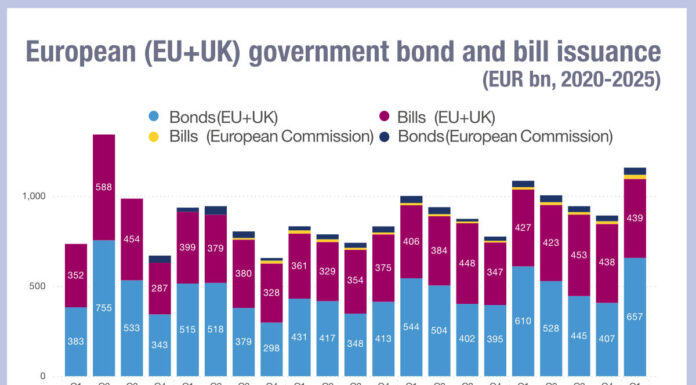 Umberto Menconi, head of Digital Markets Structures, Market Hub, Intesa Sanpaolo IMI CIB Division
Umberto Menconi, head of Digital Markets Structures, Market Hub, Intesa Sanpaolo IMI CIB Division
In fixed income markets how do different execution models (principal, matching, agency) support access to liquidity in different ways?
Before MiFID II, the taxonomy used to define different client orders’ execution models was: “Agency”, “Riskless Principal” and “Principal”. Under MiFID II, three capacities in which investment firms must report their trading were defined, replacing the previous ones:
- DEAL: when an investment firm deals on its own account;
- MTCH: when an investment firm trades in a matched principal capacity;
- AOTC: when an investment firm trades in any other trading capacity which is not DEAL or MTCH (e.g. Agency).
In fixed income, the traditional client-sales-trader workflow is based on the “Deal” trading capacity and the request for quote (RFQ) protocol from buy-side execution desks to sell-side dealers, on a bilateral basis, through voice or electronic channels. However, changes in financial markets infrastructure as well as reduced inventory capabilities are reshaping the central role of that workflow. It has moved towards a new multilateral approach, where the traditional RFQ model is still central, but with more weight given to CLOB and All-to All protocols, and to AOTC (Agency) and MTCH trading capacities. Using Italy as our example, we can say that the Agency Model has been the most common trading model used to execute orders on behalf of clients on the Italian Exchanges’ fixed income platforms (MOT, ExtraMOT and EuroTLX), where the retail order component is still very relevant.
Best execution is the main driver behind these changes and, particularly in the fixed income space, by the search for new liquidity sources and price discovery. Different execution models can access liquidity in various ways, depending on several factors such as type of investor (retail, professional, qualified), type and order size, trading venues’ authorised protocols, market risk adequacy, asset class, market volatility, instrument liquidity status and type of order workflow (e.g. D2D, B2B, B2B2C).
Different execution models have a different impact on (i) clients’ execution policy, trading costs analysis and calculating best execution factors (i.e. total consideration, speed and probability of execution), (ii) dealer pricing models and balance sheet and (iii) MiFID/R reporting obligations.
How do those differences impact market making?
Trading capacities impact the market making business model in different ways, especially with regards to market risk profile (risk or riskless), position keeping, capital requirement, pricing and monitoring.
Pricing and liquidity in bond markets have been generally provided by market makers by answering customer RFQs. The buy side traditionally interact with the sell side by (i) calling them directly via voice, (ii) communicating via electronic messaging, or (iii) sending an RFQ through a trading platform or via direct connectivity. In this way the buy side keep their entire order, especially for large size and illiquid bonds, with just a few brokers, so minimising information leakage, while the sell side take the orders onto their books and then they look to trade out of these positions over the following days. Changes in the capital requirement regulation and after financial crisis a reduced willingness from market-makers to take on risk, made the use of balance sheets more costly, thus reducing the banks’ ability to borrow, hold or lend inventory, even if the growth in electronic trading has helped to reduce the costs of market-making and increase the inventory rotation in various ways.
As a result, they have been less likely to hold an inventory of bonds for future trading, or they offered to work client orders instead on a riskless-principal basis. In 2018 MiFID II/R introduced a clear distinction between risk-principal trading (carried out by SIs [Systematic Internalisers]) and riskless matched principal trading (carried out by OTFs [Organised Trading Facilities]). In addition, the changing nature of market-making has given rise to competition from non-traditional and largely automated new market players in some fixed income markets (HFT firms or ETF desks).
Does that also change the nature of relationships between dealer and client?
Historically, in fixed income, the relationship between broker and customer was one-to-one and mainly focused on order execution via voice/phone.
Instrument liquidity and market volatility, along with order type and size, may affect fixed income execution strategies and may force the buy side to face different trading capacities, creating additional challenges in terms of integrating them in their execution strategy and complying with best execution criteria.
While in the traditional, bilateral voice, principal-to-principal trade there is a direct relationship between the two counterparties, when moving onto a multilateral environment, a number of factors impact the nature of the relationship between the dealer and client. These include multi-asset and multi-market execution, a wider network of automated communications, anonymous all-to-all trading protocols and central limit order books (CLOB), along with new agency brokerage models.
While for more illiquid instruments and larger sizes, the high-touch bilateral component is still central, for more liquid instruments and smaller sizes, the low-touch component is of growing interest, thanks to the electronification of the order workflow and the growth of different trading capabilities.
We think that it is necessary to build a strong partnership with vendors on one side and with customers on the other, to better capture the changes in technology and in customer behaviour and to quicker reshape the service to answer these changes and adapt new relationship models.
When market volatility changes what difference does the range of models make?
Volatility is one of the main market factors to be considered when providing best execution to clients. In fixed income that factor is even more relevant, due to less liquidity (in particular, with regards to corporate bonds) and market fragmentation.
When volatility changes, a multi-execution hybrid model approach might help the sell side to reduce the level of market risk of the inventory and the buy-side execution desks to improve price discovery efficiency and liquidity search opportunities, and at the end to provide best execution to their clients.
The complexity generated by this new multi-execution strategy may disrupt smaller customers, due to the increased cost of technology. For this reason, the ability of a brokerage team to provide a one-stop, multi-execution shop supported by a strong understanding of clients’ requirements, can offer customers flexibility in terms of price discovery and execution model (through hybrid models composed of voice and electronic, low-touch and high-touch business) which may represent a business opportunity for an agency brokerage team and an advantage for smaller buy-side execution desks, outsourcing their execution strategy.
How do you see the range of execution models evolving, and how does it interplay with trading protocols on e-trading venues?
The evolution of various execution models is mainly driven by technological innovation, regulatory changes and the development of communications networks.
The flexibility of execution strategies to comprehend different execution capabilities in only one trading space is essential for a brokerage team to interplay with market fragmentation, multi-asset buy-side execution desks and different e-trading venues’ protocols.
Even if the traditional client-sales-trader workflow remains centric in the evolution of fixed income market, we expect in the future to see a growing interest in alternative trading models, following more market transparency, more accessible, aggregated and meaningful market data, new market players and, last but not least, electronic and algorithmic facilitations. If we consider for a moment new digital bonds, which have recently been released in the markets, we can imagine a continuation of this transformational trend in the fixed income markets in the future, which will also force the evolution of trading models.
Umberto Menconi is indebted to Federico Cacia for his assistance in composing this article
©Markets Media Europe 2025

























